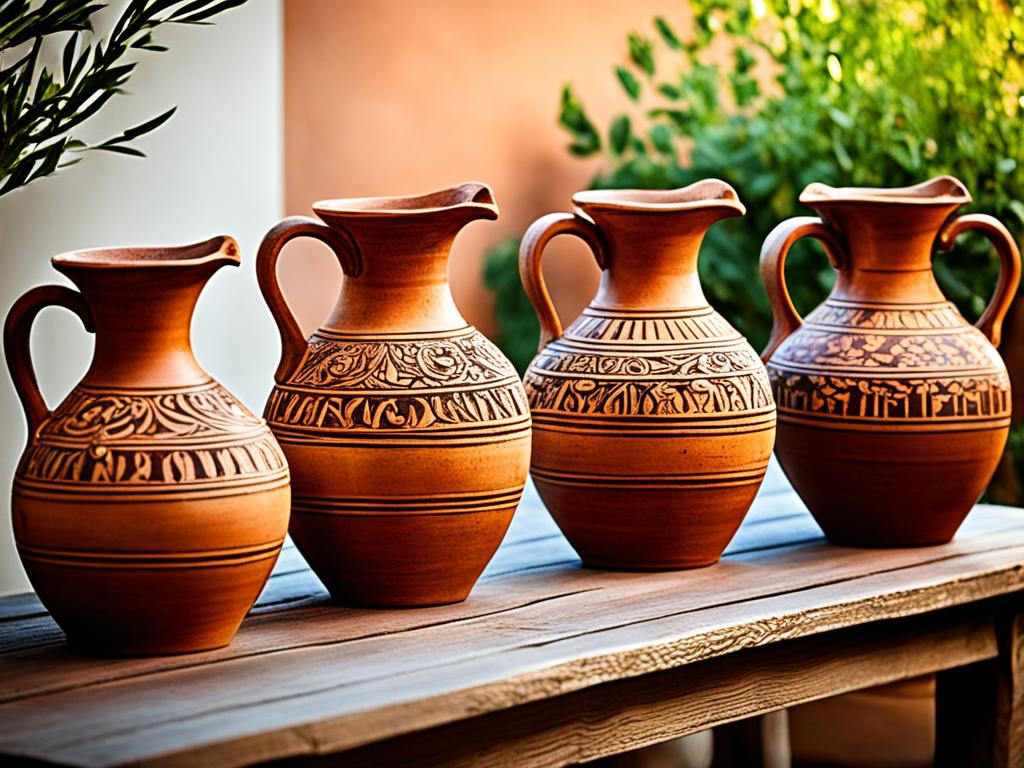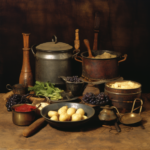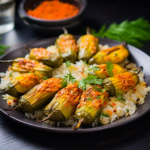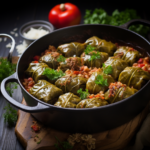Exploring ancient Greek cuisine reveals a world filled with charm. Traditional Greek cooking tools like the amphora and hydria tell a tale of rich culture. The amphora was key for storing wine, oil, and fruits, shaping daily life. The hydria, with its three handles, was crucial for keeping and moving water.

The “cup of Pythagoras” is a fascinating example of Greek wisdom. This smart cup would spill if filled too much, teaching moderation. Besides, the use of Greek clay pots was widespread. These pots cooked ingredients slowly, whether in ovens or under coals, blending flavors perfectly.
The toolkit of ancient Greece was diverse, including metal and wooden items. Metals were tough and good for eating and serving. Wooden tools, however, were key in preparing food. Learning about these tools helps us appreciate Greek creativity and their cooking legacy.
Key Takeaways Ancient Greek Cooking Equipment
- The amphora was vital for storing wine, oil, and fruits.
- The hydria, a three-handled vessel, was essential for water storage and transport.
- The “cup of Pythagoras” taught moderation with its unique spill-over mechanism.
- Greek clay pots were used for slow cooking methods, reflecting their culinary traditions.
- Both metal utensils and wooden tools were fundamental in ancient Greek kitchens.
- Understanding these tools highlights the ingenuity and lasting legacy of Greek cookware.
The Influence of Ancient Greek Culture on Modern Cooking
Ancient Greek food was simple and used fresh, local items. It still shapes how we cook today. Recipes from ancient Greece carry traditions forward. They show the importance of eating together and using special Greek kitchenware.
The old ways of cooking like boiling, frying, and grilling are still used. These methods fit the Mediterranean focus on fresh, local food. Ever since ancient times, this has been key to Greek food.
Clay pots were the first cooking tools in ancient Greece. They are still loved worldwide for making foods taste better when cooked slowly. Many modern Greek kitchens have these pots, showing their lasting worth.
In a time without fridges, Greeks smoked, dried, salted, and stored food in ways to keep it fresh. These smart techniques from the past help us keep food today.
In ancient Greece, cooking tasks were split by gender. Men roasted meats and women boiled and baked. This set early kitchen roles. Today, cooking tasks bring families together, keeping the spirit of Greek meals alive.
Ancient Greeks were creative with bread. They used it for scooping food, cleaning, and even as food for pets or slaves. This showed their knack for sharing and being resourceful. These bread traditions continue in Greek meals today.
Greek love for wine and spirits comes from a long history. The country’s hills were covered with vineyards. This past supports Greece’s fame for excellent wines and spirits today.
Souvlaki shows the continuing tradition of Greek cooking. It comes from ancient methods of roasting meat. This points to how Greek cooking values simplicity and tradition.
Master Your Kitchen with These Essential Greek Cooking Utensils: A Guide to Traditional Greek Cooking Equipment, Classic Greek Kitchen Essentials, and Ancient Greek Cooking Tools
Enhance your culinary skills by discovering the best Greek cooking tools and essential Greek cooking utensils. Dive into the world of authentic Greek recipes with the right equipment at your fingertips.
Common Materials Used in Greek Kitchenware
Greek cooking utensils mix tradition with practical use. Ancient Greeks relied on various materials for their famous dishes, chosen for their unique benefits in food preparation.
Clay Pots
Clay pots are key in Greek cuisine. These pots are valued for their heat retention and distribution, ideal for dishes like lamb and vegetables. Originating in ancient Greece, their use extends to modern kitchens through ceramic cookware.
Metal Utensils
Metal utensils are vital in Greek kitchens. They’re used in roasting, grilling, and serving food, thanks to their durability and versatility. Large saucepans are used for Greek recipes, and metal baking pans are essential for various baked goods. Spit roasters are traditional for roasting meats during celebrations like Easter.
Wooden Tools
Wooden tools are preferred in Greek cooking for their insulation from heat. Wooden spoons help keep flavors intact while stirring sauces. Wood cutting boards are chosen over plastic for hygiene, and a wooden rolling pin is crucial for dough in Greek baking.
Below is a table of key Greek cooking utensils and their uses:
| Kitchen Utensil | Use |
|---|---|
| Wooden Spoons | Stirring sauces, soups, and other dishes |
| Mortar and Pestle | Grinding spices and herbs for flavorful results |
| Olive Oil Cans | Conveniently dispensing olive oil in cooking |
| Cheese Grater | Grating cheeses, a staple in Greek cuisine |
| Spice Grater | Grating spices to enhance aroma and flavor |
| Pepper Grinder | Adding freshly ground pepper to recipes |
| Skewers | Making souvlaki, a popular Greek dish |
| Whisks | Preparing traditional sauces like latholemono and avgolemono |
| Large Saucepans | Cooking intricate recipes with multiple components |
| Metal Baking Pans | Baking sweet and savory dishes |
| Spit Roaster or Rotisserie | Roasting whole lamb or goat |
| Honey Dipper | Using and drizzling honey in desserts |
| Pastry Brushes | Greasing pans, brushing oil/butter on dough |
| Wood Cutting Boards | More sanitary option for meal preparation |
| Clay Pots | Slow-cooking dishes evenly |
| Rolling Pin | Rolling out dough for pastries and desserts |
Ancient Greek Cooking Equipment Methods
Exploring the history of Greek cooking shows fascinating techniques from the past. The charm of cooking on an open fire, using wood-fired ovens, and ancient ways to keep food fresh influenced today’s kitchens.
Open Fire Cooking
Open fire cooking was key in ancient Greek kitchens. A variety of foods, including meats, were cooked over flames. Meats like lamb or goat were often roasted on a spit, a method that added a smoky flavor still popular in Greece today.
Clay Ovens
Clay ovens were essential in Greek cooking. Similar to modern pizza ovens, they were used for slow cooking. Ingredients sealed in clay pots were cooked for hours, either in or over hot coals. This slow process made the foods flavorful and tender, a method still used in Greece.
Food Preservation Techniques
Before fridges, ancient Greeks developed food preservation methods. Smoking, drying, and salting kept their food safe and fresh. They also preserved fruits and meats in syrups and fat, showing their cleverness in making food last.
The ancient techniques of Greek cooking and preservation still affect how we prepare and store food today. These timeless methods showcase the Greeks’ culinary skill and their ability to innovate in the kitchen.
Amphoreas: The Multipurpose Storage Vessel
Amphoras were key in ancient Greek homes. They beautifully met various storage needs. Crafted with two handles, they were easily moved around. They stored many important items, essential for Greek food storage and trade.
Storing Wine
Amphoras were mainly used to store and ship wine. These Greek wine pitchers kept wine fresh with their airtight seals. Their narrow necks reduced air exposure, keeping the wine good for longer.

Storing Oil
Amphoras also stored olive oil, a Greek kitchen staple. These Greek olive oil vessels had a special coating inside. It kept the oil from leaking and ensured it stayed fresh.
Storing Small Fruits
Besides liquids, amphoras were perfect for small fruits. They protected fruits like figs and dates from pests and spoilage. Their sturdy design helped keep the fruits’ taste and health benefits.
Pythagoras’ Cup: A Lesson in Moderation
The Pythagoras’ fair cup shows how smart the ancient Greeks were with technology. It teaches us to balance our desires using a clever trick. If you pour too much into the cup, it empties everything out. This teaches us not to take more than we need.
This lesson from the past shows the Greeks were wise and thoughtful. The Pythagoras’ fair cup is not just a smart invention. It’s proof of their deep knowledge in hydraulic technology and their belief in balance and ethical living.
At the Kotsanas Museum of Ancient Greek Technology in Athens, there’s a copy of this special cup. It’s part of an exhibit showing how creative the ancient Greeks were. From automatic theaters to flying machines, they thought of it all.
At a STEM Fair in Technopolis, Athens, I saw something awesome. Middle school kids were showing off how the cup works. They taught visitors about the science behind this amazing device.
The story of the Pythagoras’ fair cup teaches us something important today, just like Trend Hunter does. Trend Hunter reaches millions worldwide with its innovative ideas. With books, videos, and a big social media following, it mixes old wisdom and new tech. Just like the ancient Greeks, it shows us that some ideas are timeless.
Ancient Greek Cooking Equipment: The Essential Tools
Diving into traditional Greek cooking tools is quite the adventure. We find that the Greek mortar and pestle are crucial. They grind spices and herbs, giving Greek food its unique flavor. These tools were made by hand with utmost care, essential for preparing meals every day.
When cooking, I love using ancient Greek culinary tools for their unique blend of charm and function. Wooden spoons stand out because they don’t conduct heat. They also don’t react with acidic foods, keeping the food’s flavor pure while stirring.
- Mortar and Pestle: Used for grinding spices and herbs.
- Wooden Spoons: Ideal for non-reactive stirring.
- Cheese Grater: Essential for grating cheese.
- Spice Grater: Enhances the aroma of spices like cinnamon and nutmeg.
- Olive Oil Can: Important for storing olive oil.
- Skewers: Perfect for souvlaki.
- Spit Roaster/Rotisserie: Used for roasting whole lamb or goat.
- Large Saucepans: Necessary for multi-component recipes.
Both chefs and home cooks can benefit from these classic tools. Let’s look at the most important items:
| Tool | Usage | Importance in Greek Cuisine |
|---|---|---|
| Greek Mortar and Pestle | Grinding spices and herbs | Essential for traditional recipes |
| Cheese Grater | Grating cheese | Enhances dish flavors |
| Spice Grater | Grinding spices like cinnamon and nutmeg | Improves aroma and taste |
| Olive Oil Can | Storing olive oil | Key ingredient in Greek dishes |
| Skewers | Preparing souvlaki | Popular Greek street food |
| Spit Roaster/Rotisserie | Roasting whole lamb or goat | Traditional festive cooking |
| Wooden Spoons | Stirring and mixing | Non-reactive with food ingredients |
| Large Saucepans | Cooking multi-component recipes | Versatile utility |
By adding these ancient Greek tools to your kitchen, you bring both authenticity and tradition. From the mortar and pestle to wooden spoons, each tool has deep roots in Greece’s culinary history.
Hydria: The Ancient Greek Water Carrier
The hydria is known for its unique three-handle design. It was crucial in ancient Greece for storing and moving water. This vessel was not just practical for everyday use; it also showed off the advanced pottery designs of ancient Greeks.
Design And Features
The hydria’s design was extraordinary. Made from terracotta and bronze, these vessels often had elaborate patterns. Bronze hydriai were made using raising and casting, which allowed for both strength and detailed designs. They started with a golden sheen that turned green over time.
The hydria’s three handles were brilliantly useful. Two handles on the sides made it easy to lift and pour. A vertical handle at the back was for dipping and carrying. Thanks to its design, it was essential in homes throughout ancient Greece.
Uses in Daily Life
Ancient Greeks found the hydria crucial for daily tasks. It was used for fetching and storing water and in ceremonies. These vessels also helped in washing, bathing, and as offerings.
The hydria shows the artistry of ancient craftspeople. They excelled in creating balanced, well-proportioned, and patterned pieces. The hydria, whether made from bronze or other materials, stands out in Greek pottery for its usefulness and beauty.
Nowadays, replicas and original hydriai can be found. For instance, a hydria water jar costs $114.90 and is available for international shipping. It shows how the hydria’s design and appeal are timeless.
Greek Bakeware Through the Centuries
Greek cuisine has changed a lot since ancient times. This change comes from new ideas in bakeware. Let’s explore the history and innovation of Greek ceramic bakeware. We will focus on how it evolved and the start of non-stick technologies.
Development of Ceramic Pans
The early Greeks loved using clay pots. They used them for boiling, frying, simmering, and stewing foods like cereals, legumes, and meat. They sealed these pots tightly. Then, they baked them in clay ovens or buried them under hot coals. This method was simple but effective for cooking without today’s tools.
When ceramic technology got better, Greek ceramic bakeware made big steps forward. These pans were versatile, suiting many cooking styles. This helped the success of Mediterranean cuisine. The ceramics were durable and convenient, showing the Greeks’ talent for inventing kitchen tools.
Non-Stick Innovations in Ancient Greece
The most interesting advancement in Greek bakeware was non-stick technology. Researchers found pans in Mycenaean Greece with a smooth coating. This was an early version of a non-stick surface. This innovation shows the ancient Greeks were really creative with their kitchenware.
Greek ceramic bakeware was practical and showed cultural creativity. With these advanced techniques, the ancient Greeks set the stage for today’s non-stick cookware. Their cooking methods have lasted through the ages. They continue to influence kitchens all over the world.
| Era | Innovation | Material |
|---|---|---|
| Ancient Greece | Basic Clay Pots | Clay |
| Mycenaean Greece | Non-Stick Coating | Ceramic |
| Modern Times | Enhanced Non-Stick Technology | Various non-stick materials |
The Role of Olive Oil in Greek Culinary Practices
Olive oil is not just a cooking ingredient in Greece; it’s a major part of their culture. With around 120 million olive trees, it’s clear why so many Greeks work with these trees. Each person in Greece uses more than 25 liters of olive oil every year. This shows how important olive oil is in their food and traditions.
Olive Oil Vessels
Throughout history, Greeks have used special containers for olive oil. These include amphorae, which were designed with two handles for easy carrying. The amphorae’s shape helped keep the oil fresh. Not only were these containers used in homes, but they also helped in trading olive oil worldwide. Greece is known for exporting high-quality Extra Virgin Olive Oil, which has to have an acidity level below 1%.
Preservation with Olive Oil
In Greece, olive oil has been a key preservation tool along with its cooking uses. By keeping food in olive oil, it stays fresh longer because the air can’t get to it. This was especially useful before we had fridges. Olive oil is also part of the Mediterranean Diet, which helps lower the risk of many diseases.
Olive oil is essential in many Greek dishes, from seafood to festive meals like lamb. It’s a key reason why the Mediterranean Diet is praised all around the world. The way Greeks use olive oil continues to influence food everywhere.
FAQ
What are some examples of traditional Greek cooking equipment?
Traditional Greek cooking tools include bakeware, cookware, and clay pots. Greek wood-fired ovens and cooking utensils are also key. They were all vital in ancient Greek food making.
How has ancient Greek culture influenced modern cooking?
Ancient Greeks have shaped today’s cooking with fresh ingredients and simple methods. Communal dining and ancient equipment still influence Greek and Mediterranean cooking.
What materials were commonly used in Greek kitchenware?
Greek kitchenware was made of clay pots, metal utensils, and wooden tools. These materials were practical and long-lasting for traditional Greek cooking.
What were the main cooking methods used in ancient Greece?
Ancient Greeks cooked with open fire, like grilling and stewing. They used clay ovens for baking. Smoking, drying, and salting were key food storage methods.
What is an amphora and what was it used for?
An amphora is a two-handled vessel used in ancient Greece for storing wine, oil, and fruits. It was crucial for storing food and trading.
What is the significance of Pythagoras’ Cup?
Pythagoras’ Cup was a clever Greek invention that prevented greed through a spill-over design. It taught the value of moderation and the impact of excess.
What were the essential tools in traditional Greek cooking?
In Greek cooking, key tools were the mortar and pestle for spices, and various utensil for preparing meals. Clay pots and wood-fired ovens were also crucial.
What is a hydria and how was it used in ancient Greece?
A hydria is a triple-handled water vessel from ancient Greece. It was for carrying and serving water, aiding in daily and ceremonial tasks.
How has Greek bakeware evolved through the centuries?
Greek bakeware went from early clay pots to advanced ceramic pans. Innovations like non-stick surfaces date back to the Mycenaean era, showing ancient Greek creativity.
What role does olive oil play in Greek culinary practices?
Olive oil is key in Greek cooking and preserving food. The design of Greek olive oil vessels was for efficient storage. Olive oil remains central to Greek culture and food.


















